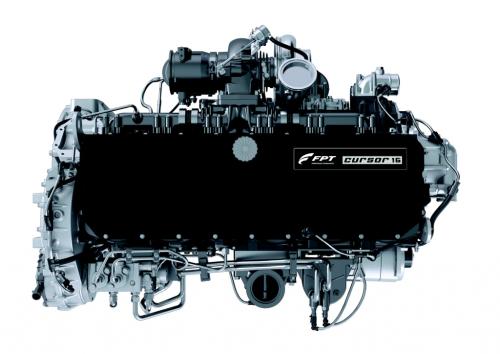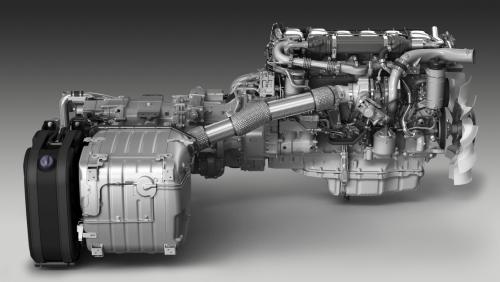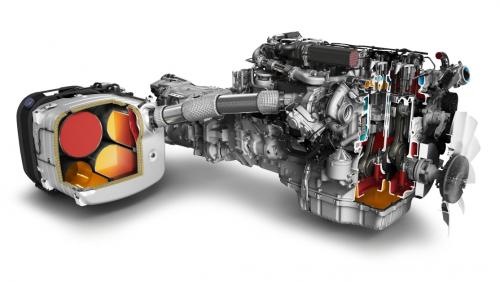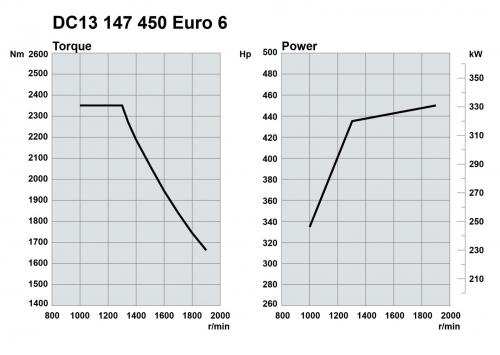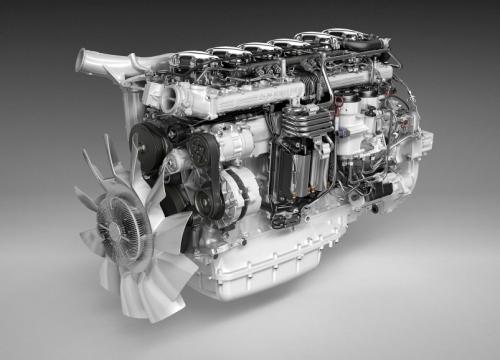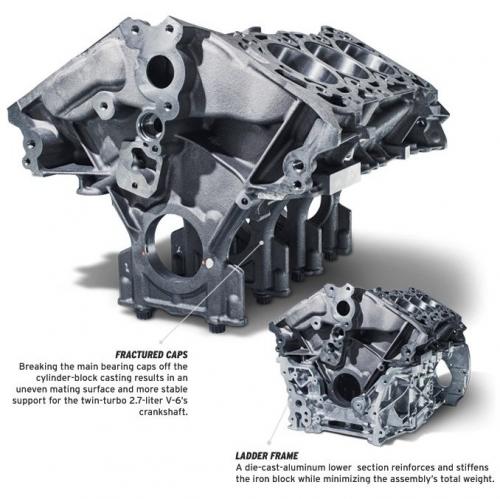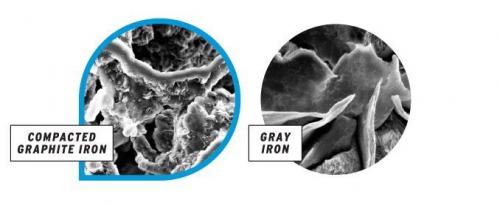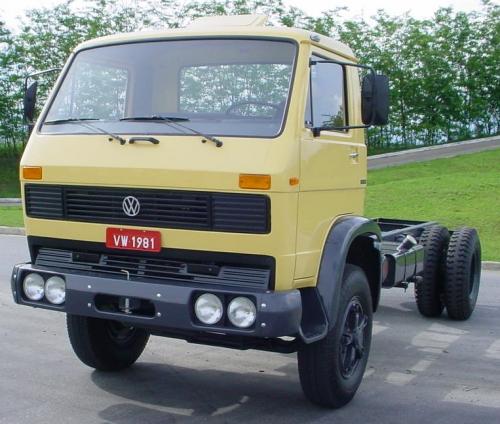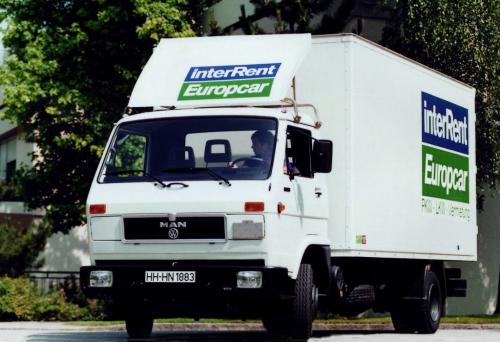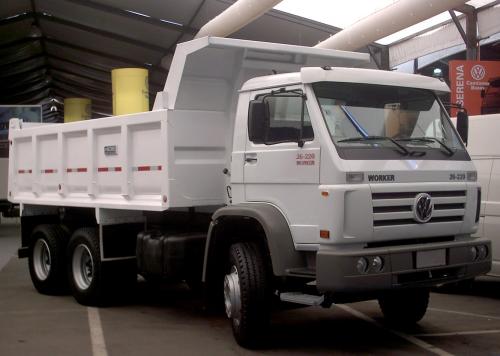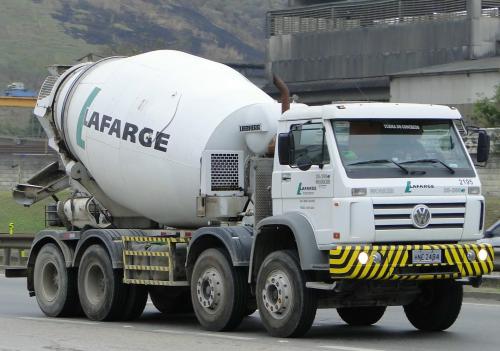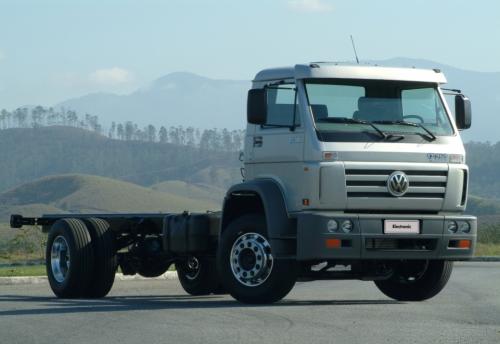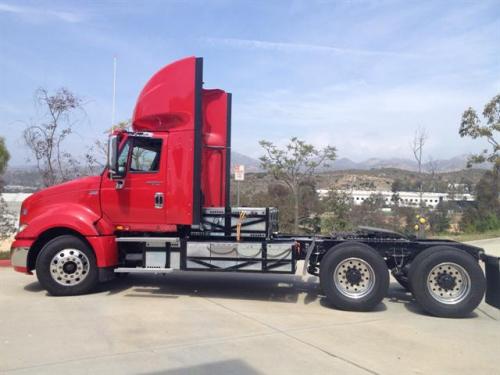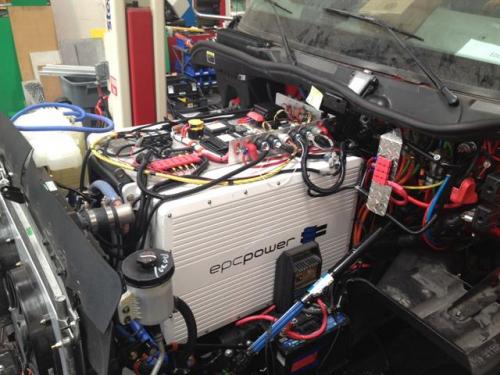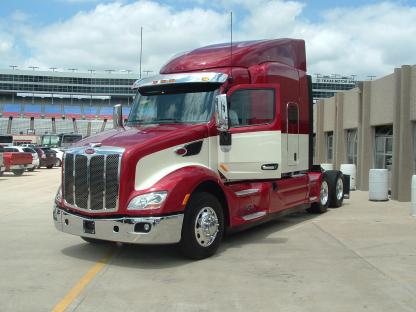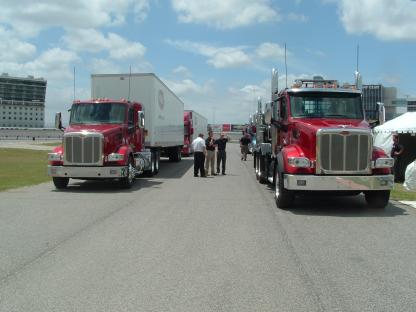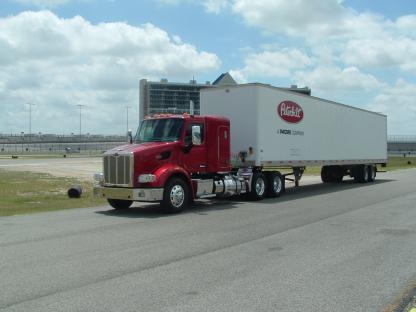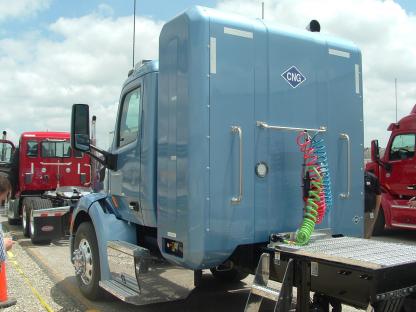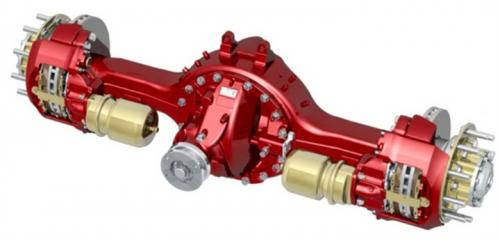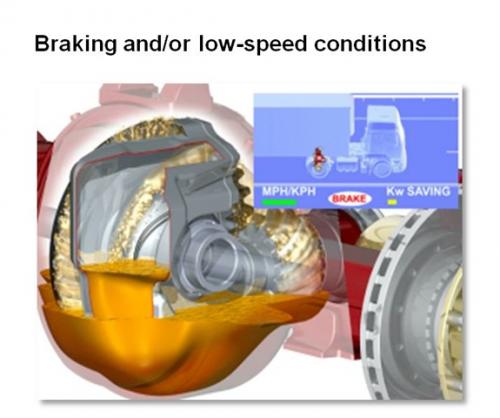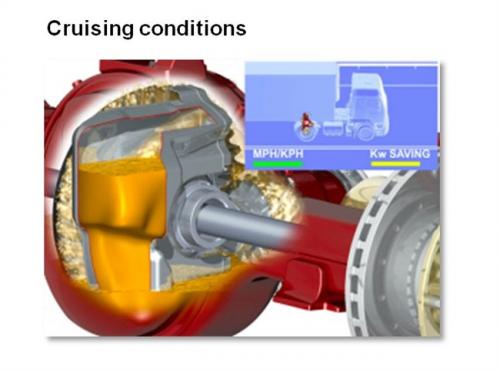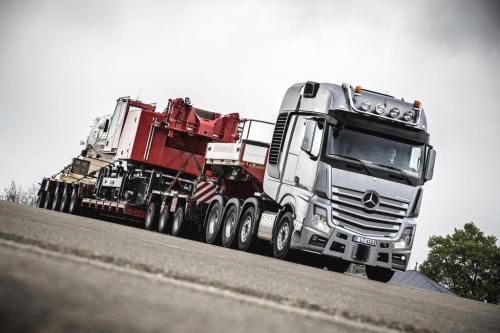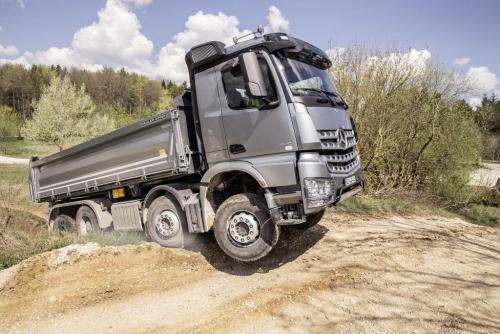
kscarbel2
Moderator-
Posts
18,876 -
Joined
-
Days Won
114
Content Type
Profiles
Forums
Gallery
Events
Blogs
BMT Wiki
Collections
Store
Everything posted by kscarbel2
-
Exactly. Volkswagen AG has never expressed any interest in Paccar. However the company continues to consider Navistar from a distance. If you say it's been reported, where is the link to the news report?
-
Bloomberg / June 4, 2014 The 70-hour cap on a U.S. trucker’s workweek has a chance of being eased by Congress, undoing the result of a 15-year effort to reduce highway fatalities caused by drowsy long-haul drivers. The main federal regulation requiring truckers to take an extended break after reaching weekly time limits would be suspended under an amendment set for a vote in the Senate Appropriations Committee tomorrow. The new rule had taken effect in July 2013 and immediately drew criticism from the industry. The suspension, which would restore the industry’s 82-hour “workweek,” is intended to force the Transportation Department to address some of the regulation’s fallout, said Kevin Kelly, a spokesman for Senator Susan Collins, the Maine Republican sponsoring the amendment. The industry has said that the rule’s requirements for scheduling rest breaks at night forced more trucks onto the road during the daytime when traffic is most congested. “What has become clear during the past 11 months is that the new federal rules have presented some unintended consequences that may not be in the best interest of public safety, truck drivers and the businesses and customers who depend on their services,” Kelly said in an interview. The regulations took effect after more than 15 years of legal wrangling over sleep science, the role of fatigue in truck crashes, and how the costs of hiring more drivers to deliver freight would ripple through the economy. Truck Crashes “At the heart of this rule is an expectation to minimize the risk when tired drivers are behind the wheel of an 80,000 pound truck,” Anne Ferro, head of the Federal Motor Carrier Safety Administration, said in an interview. “The hours are exceedingly long.” The Senate amendment, if passed, would be attached to a broad transportation funding bill that would have to be approved by the full Senate and later reconciled with appropriations legislation in the House of Representatives. Truck crashes caused 3,912 fatalities in 2012, and the fatal-crash rate increased each year from 2009 through 2012, reversing a five-year trend. The hours-of-service regulation was expected to prevent 1,400 truck crashes a year, saving 19 lives and avoiding 560 injuries. 34-Hour Restart The trucking industry and business groups that rely on trucks to deliver their goods argue that FMCSA’s rest rules, which were made final in December 2011 and took effect July 1, 2013, have affected more companies than the agency projected. The American Trucking Association and its allies said regulators hadn’t done the research or analysis necessary to justify the changes, according to a letter they sent to Senate Appropriations Committee Chairman Barbara Mikulski, a Maryland Democrat, and Senator Richard Shelby of Alabama, the panel’s senior Republican. The trucking groups said they’re most concerned with the provision that forces drivers to take 34 hours off, which must include being off the road from 1 a.m. to 5 a.m. on two consecutive days during that period. This 34-hour “restart” requirement, which begins the clock ticking on a new work week, was intended to make sure drivers got enough sleep. The 34-hour restart only is required if a driver has reached the maximum weekly limits of 70 hours over eight days or 60 hours over seven days. Rush Hour There’s nothing in the regulation that forces drivers onto the road during rush hours, Ferro said. Drivers can set their own schedules and drive at night if they wish. There’s no requirement to get on the road the minute a 34-hour rest period ends at 5 a.m., she said. The vast majority of trucking companies don’t hit the 70-hour maximum, Ferro said. For 85 percent of drivers, it’s a non-issue, she said. The rules were written only after an extensive review of medical research on what human beings need to reduce fatigue, Ferro said. The agency held hearings across the country to gather industry input and reviewed more than 20,000 public comments, she said. Most of the companies that have been affected have already made the necessary investments to comply, through new agreements with shippers, reworking schedules and adjusting networks, Ferro said. Reversing the rules now would reward companies that have dragged their heels, while punishing those who have played by the rules, she said. Industry Cost The segment of the industry pushing the hardest for changes is relying on a system that shortchanges drivers, including forcing them to wait at loading docks, racking up hours of unpaid work, Ferro said. FMCSA won a U.S. Court of Appeals decision in August challenging the rules. The three-judge panel in Washington rejected most of the trucking industry’s arguments, describing them as “highly technical points best left to the agency.” That ruling capped years of wrangling over drive-time restrictions including two previous challenges before the appellate court. The court also ruled against groups including Public Citizen and the Truck Safety Coalition that said the rules didn’t go far enough. The final regulation was projected to cost about $470 million a year, with public safety and trucker health benefits of around $630 million. ‘Permanent Warfare’ Perhaps prematurely, the court said its decision would end the “permanent warfare” the regulatory battle had come to resemble. That was before trucking companies struggling to implement the regulations began complaining to Congress. None of the industry arguments ring true to Daphne Izer, the founder of Parents Against Tired Truckers, which has pushed for tighter rest rules for 20 years. The Lisbon, Maine, resident founded the group after her 17-year-old son, Jeff, and three of his friends were killed by a fatigued truck driver. Collins hasn’t spoken to her constituent as she has been crafting the Senate amendment, which Izer describes as a “back-door way of sneaking it in.” “This is fighting the battle all over again,” Izer said in an interview. “I’m mad, but I’m not doing this just to be angry. It’s hope for the future. It’s sparing others from going through what we’ve been through.”
-
Press Release / May 8, 2014 Italian truckmaker Iveco’s engine supplier, FPT, has launched the new Cursor 16. “We’re pleased to be able to reveal the engine to the public for the first time. Every now and then there is a massive leap in engine development and performance; FPT Industrial has achieved this with the Cursor 16,” said FPT Industrial’s Sales Vice President Massimo Rubatto. The new Cursor 16 offers best in class power and torque density, rated and max power as well as service intervals, crafted in a compact design to make it one of the smallest engines in its range. The Cursor 16 delivers 18-litre performance in a 13-litre package. It utilizes proven technology and represents the top level of the successful Cursor Series engine family, renowned for its reliability and flexibility. The 15.9-litre, six-cylinder in-line engine will be available in two versions: single stage turbo and dual stage turbo. The new engine is designed with the performance and durability to exceed the needs of heavy hauling applications, with the second stage version offering a fuel economy advantage in high load factor operations. The Euro-6 (EPA2010) emissions engine, with four valves per cylinder, delivers up to 764 horsepower (570 kW) with maximum torque of 2,449 lb-ft (3,320 Nm) at 1,500 rpm in its single stage version, and up to 845 horsepower (630 kW) with maximum torque of 2,581 lb-ft (3,500 Nm) at 1,400 rpm in its double stage version. The Cursor 16 is the first FPT engine to adopt a Compacted Graphite Iron (CGI) cylinder head, a high performance material providing high thermal and mechanical resistance. To be produced in FPT’s Bourbon Lancy plant in France, the Cursor 16 engine has been co-developed by FPT Industrial’s Research and Development teams in Arbon, Switzerland, and Turin, Italy. Combustion is optimized by the use of steel pistons, creating high peak cylinder pressure and, as a result, high power density and low Particulate Matter (PM) output. Combustion optimization is furthered with a FPT-developed double re-entrant combustion bowl, two different turbulent vortexes within the bowl allow for the accurate control of fuel and air mix to maximize performance and minimize emissions, while ensuring no residual fuel is left on the cylinder lining. The engine features a third generation ultra-high pressure common rail fuel injection system, of up to 2,200 bar, allowing a precise control of the injection process. The Cursor 16’s ball bearing turbocharger with wastegate further increases engine efficiency. FPT’s patented High Efficiency Selective Catalytic Reduction (HI-eSCR) technology is also utilized. Developed in-house to comply with Euro-6 emission regulations, the system reduces Nitrogen Oxide (NOx) emissions by more than 95%. With no PM after-treatment system and the high power delivery potential without a mandatory air handling system, the HI-eSCR system increases reliability and lowers maintenance cost, while reducing operating costs over the entire product lifecycle. The compact system allows for the optimization of space and minimizes the weight impact due to integrated components. In addition to its power and efficiency improvements, noise and vibration reduction has been achieved by the use of a rear geartrain timing system. Cursor 16 15.9 – Single stage (turbocharger) with wastegate Architecture: In-line 6-cylinder engine Injection – Ultra-high Pressure Common Rail (up to 2,200 bar) Valves per cylinder: 4 Displacement (l): 15.9 Unitary displacement (l): 2.65 Bore per stroke (mm): 141 x 170 Stroke/bore ratio: 1.21 Compression ratio: 16.5:1 Power range (rated hp): 644 / 691 / 764 Max torque (lb-ft @rpm): 2,205 (2,449 for 764hp rating only) @ 1,500 Dry weight (lb): 2,910 Dimensions (mm) L / W /H: 1,378 / 951 / 1,326 Cursor 16 15.9 – 2-stage (dual turbochargers) Architecture: In-line 6-cyliner engine Injection – Ultra-high Pressure Common Rail (up to 2,200 bar) Valves per cylinder: 4 Displacement (l): 15.9 Unitary displacement (l): 2.65 Bore per stroke (mm): 141 x 170 Stroke/bore ratio: 1.21 Compression ratio: 15.5:1 Power range (rated hp): 697 / 805 Power range (peak hp): 724 / 845 Max torque (lb-ft @rpm): 2,581 @ 1,400 Dry weight (lb): 3,197 Dimensions (mm) L / W /H: 1,378 / 1,010 / 1,326 .
-
Scania Launches New 450hp Engine with SCR Only
kscarbel2 replied to kscarbel2's topic in Trucking News
Scania’s new 450hp non-EGR powerplant meets Euro-6 (EPA2010) emissions levels using only SCR. As a result, the engine is inhaling 100 percent fresh air without any reduction in oxygen levels. Unlike engines with EGR, no percentage of fresh air intake is reduced, displaced by recirculated levels of exhaust gases (typically ranging from 18 to 30 percent). Without EGR (exhaust gas recirculation) piping, the “SCR only” powerplant realizes a weight savings of 88 pounds (40kg). Scania’s pure SCR solution also allows the use of a fixed geometry turbocharger rather than a more complex variable geometry unit. Exhaust aftertreatment remains the same, using a Tenneco-supplied module including an upstream NOx sensor, a diesel oxidation catalyst (DOC), a diesel particulate filter (DPF), AdBlue dosing module, two parallel selective catalytic reduction (SCR) catalysts with ammonium slip catalysts (ASC), and a downstream NOx sensor. Note that muffler and aftertreatment are brilliantly integrated into one compact module for efficient chassis packaging. While the folks in Gothenburg (Volvo) are toiling away at trying to extract and replicate the latest engine technologies of Daimler and MAN, the cutting edge engineers of the global truck industry at Scania continue a tradition of impressive innovation. Scania powertrain engineering truly is the benchmark for the global truck industry. . -
Press Release / June 3, 2014 Scania has now further broadened its already comprehensive range of Euro 6 (EPA2010) certified truck engines. Anyone who needs 450 horsepower, not least European customers with tractor-trailers, can now choose between two versions of Scania’s well known 13-litre engines at that power level. In its latest configuration it uses only SCR aftertreatment technology, and thus is expected to become a strong favorite among customers, especially long-haulage firms who prioritize low diesel consumption. “Our success with the 410 hp version of the 13-litre engine with only SCR has spurred us to go further down the road to reduce both complexity and diesel consumption,” says Joel Granath, Head of Product Management for Scania trucks. “Our customers now have a range of 18 different models of Euro 6 engines to choose from. This gives them unique opportunities to tailor their powertrains for optimal performance, regardless of driving conditions or application.” Because Scania engineers solved the puzzle of meeting tough Euro 6-emission requirements using only SCR – despite the high power range – customers now get increased freedom of choice with simpler solutions. The new Scania engine model – DC13 147 – requires neither a variable geometry turbocharger nor an EGR cooler. “Just as with the extremely fuel-stingy 410 hp model that appeared last autumn, this engine is ideal, especially for European long-haulage customers who prioritize low fuel consumption, but don’t want to give up torque or driver comfort,” states Granath. “According to our own calculations running a Scania Streamline, this results in a 1 percent fuel saving compared with the previous model using both EGR and SCR – everything else being equal.” Engines using only SCR technology require more AdBlue (DEF), on the other hand. In the case of Scania, this is normally an average of 6 percent of diesel fuel, while engines with EGR and SCR normally come up to 3 percent. For those who want to optimize their diesel fuel capacity, Scania offers a wide assortment of AdBlue tanks, including special solutions that use vacant space inside the frame in an intelligent way. The new engine model has, just like its predecessor, a very impressive torque: maximum torque is 2,350 Nm and is available right from 1,000 r/min, which assures very good driveability. “We are convinced that Scania’s 450hp engine with only SCR will become a popular workhorse out on the highway,” says Granath. “Using only SCR for aftertreatment has been shown to lead to lower consumption, and it also saves some weight.” “Euro 6 customers who have the advantage of being able to run on up to 100 percent biodiesel should look at the specially adapted version of Scania’s 450 hp engine range. That version uses both EGR and SCR for aftertreatment, just as before. http://www.scania.com/Images/wkr0006_tcm40-427362.pdf .
-
Claims Journal / May 1, 2014 The Department of Transportation (DOT) is seeking to mandate the use of speed limiters on trucks weighing over 26,000 pounds and traveling on roads with a speed limit of at least 55 mph. The department’s March 2014 “Report of Significant Rulemaking” states the new rule may take effect by October of this year. The DOT has not commented on the speed to which the heavy trucks would be limited, but previous proposals had included a limit of 68 mph. Advocates say that the rule would eliminate approximately 1,115 fatal crashes and require minimal investment by carriers since most heavy trucks already have limiters on board. The American Trucking Association (ATA) has asked for limiters on all new trucks, and the safety advocacy group Road Safe America (RSA) has proposed retrofitting all vehicles manufactured since 1990. Many fleets already limit the speed of their trucks with electronic governors. In the U.S., the National Highway Traffic Safety Administration (NHTSA) began looking at mandatory speed limiters on heavy-duty trucks in 2011. Two petitions for rulemaking were originally brought in 2006 by the ATA and the RSA, joined by nine motor carriers – Schneider National, Inc., C.R. England, Inc., H.O. Wolding, Inc., ATS Intermodal, LLC, DART Transit Company, J.B. Hunt Transport, Inc., U.S. Xpress, Inc., Covenant Transport, Inc., and Jet Express, Inc. The petition stated that a key strategy in preventing large truck fatal crashes is to reduce the top travel speed of the fleet. They cite studies showing that large trucks moving at high speeds have much longer stopping distances than the same trucks operated at lower speeds. Fatal crashes involving trucks are more prevalent on higher speed roadways, with 73 percent of traffic fatalities involving large trucks traveling on roads with a posted speed limit of 55 mph or higher. According to reports issued by the NHTSA and Federal Motor Carrier Safety Administration, and the Insurance Institute for Highway Safety (IIHS), large trucks are involved in fewer accidents than other types of vehicles per 100 million miles driven, but these accidents have a higher rate of fatalities. The DOT reports that: There were more than 1.1 million interstate motor carriers including for-hire, owner operators and private carriers (business fleets) as of December 2010.In 2007 (last available data), the Commodity Flow Survey reported that trucks hauled more than $8.3 trillion worth of goods.Approximately 11 billion tons of freight is moved each year.In 2009, 529 large truck occupants were killed in crashes.In 2009, 20,000 large truck occupants were injured.Annually, approximately 500,000 accidents involving trucks occur.In 2010, there were 1.1 fatal crashes per 100 million truck miles.Though the statistics vary depending on who is issuing the report, the commonality is that truck crashes are rising and often involve a fatality. The IIHS reports that in 2010: 286,585 million miles were traveled by trucks.3,413 people died in accidents involving large trucks.14 percent of the deaths were occupants in the truck.72 percent of the deaths were occupants in a different vehicle.13 percent of the deaths were people on motorcycles, walking, or riding bicycles.The number of fatalities rose by 8 percent compared to 2009.Large trucks accounted for 4 percent of registered vehicles but 9 percent of motor vehicle crash deaths.75 percent of truck accidents involving fatalities were tractor-trailers and 25 percent were single large trucks.The DOT did a detailed study called “The Large Truck Crash Causation Study” to analyze truck crashes occurring between 2001 and 2003. It reported that events that led to crashes included: loss of control of the truck after driving due to some event like a tire blowout;disabling or non-disabling vehicle failure – engine problem or hood flew up;another motor vehicle encroaching on the truck’s lane;poor road conditions due to poor road maintenance or weather;traveling too fast for road conditions;shifting cargo;lane drifting – either truck or passenger vehicle;driving off the edge of the road;improper truck maneuvering during events (turns and passing through intersections);coming upon a stopped vehicle;finding objects on the highway; anddriver fatigue.Reports show that 61 percent of fatalities occur on major roads other than interstate highways. Trucks often weigh as much as 30 times more than a passenger vehicle, so the smaller vehicle’s passengers are more likely to die in an accident involving a large truck. Tractor-trailers also require more stopping distance, especially when loaded, and need a correspondingly increased amount of time to react in order to avoid a crash. Many truck drivers are opposed to the new proposals. The Owner Operator Independent Drivers Association (OOIDA) has made excellent counter-arguments which boil down to, “Be careful what you wish for.” OOIDA argues that studies show that speed differentials lead to more collisions, so it’s safer to keep traffic moving at the same speed – something everybody who has pulled behind a truck traveling in the fast lane and trying to pass trucks in the slow lane traveling only 1-2 mph slower than their vehicle will attest to. Trucks all governed similarly won’t be able to pass each other. OOIDA also cites studies which say that car drivers (usually losing patience with slow-moving trucks) cause most of the collisions with big trucks when there is a fatality. OOIDA also notes that large trucks are not over-represented in fatal accidents. While they are only 3 percent of all vehicles, they drive 9 percent of all miles driven and are involved in about 11 percent of all fatal crashes. Lastly, OOIDA says that it is the states’ rights to set speed limits. According to the DOT the proposed speed limiter rule is slated to be sent to Secretary of Transportation Anthony Foxx for approval this month and then sent to the White Houses’ Office of Management and Budget in June. If it succeeds, the rule could be published as a Notice of Proposed Rulemaking in October. Fleets love them, and drivers hate them. But one thing is sure – the debate is not likely to end if the proposal is enacted. In fact, that’s when it will begin.
-
New Fee Structure for Pennsylvania Permits Starting July 1
kscarbel2 posted a topic in Trucking News
Heavy Duty Trucking / May 30, 2014 The Pennsylvania Department of Transportation will implement a new fee structure will be enacted July 1 for all types of permits, ranging from single trip/overdimensional, overweight, to annuals and seasonal permits, according to the Specialized Carriers & Rigging Association. Any increases in fees appear to be modest and this is the first change in the fee structure in over 20 years. The main impacts are an increase in the minimum overdimensional fee from $26 to $35 and an increase in the cost per ton mile from 3 cents per mile to 4 cents per mile. The new fee schedule is available from Pennsylvania’s Automated Permit Routing/Analysis System website. -
Russian truckmaker Ural has launched a new conventional truck model utilzing the cab from its GAZelle light commercial truck platform. http://trucks.autoreview.ru/_archive/section/detail.php?ELEMENT_ID=137796&SECTION_ID=7792 http://eng.gazgroup.ru/buyers/lcv/gazelle/
-
April activity points to Q2 seeing prices increase on resale and auction marketsFleet Owner / June 2, 2014 If April is any indication of how the used-truck market will perform in Q2, prices will be rising in both the resale and auction markets, according to the “Commercial Truck Monthly Report” for April on the vehicle-resale market prepared by The Truck Blue Book (TBB). The report states that April brought on price increases of 14% and 33% in those markets, respectively. What’s more, prices were higher than Q1’s average price by almost 4% and 2% in the resale and auction markets. “Heavy-duty prices increased 13% compared to Q1 in the asking-price market and medium-duty prices increased 11% compared to Q1 in the auction-price market,” the report’s author Jessica Carr, TBB’s associate analyst-- commercial trucks, told FleetOwner. She also noted that “volume fell in every market except medium-duty asking prices, where it rose 11%.” Carr also advised that “April showed positive change in asking and auction prices for the start of Q2.” And while asking prices increased across all five regions tracked, she said “volume was down drastically throughout April on the heavy-duty market.” Per Carr, April saw price increases across the board after the “minimal changes” seen during March. Key takeaways from the April report include: - Heavy-duty market recorded increases on both asking and auction prices at 15.7% and 30.8%, respectively - Medium duty saw a smaller change, however, it was also in a positive direction-- with 3.5% in asking price and 6.3% in auction prices - Volume on the auction market fell for both heavy and medium duty, at 42% for heavy and 66% for medium while the asking volume dropped for heavy at 22.6% and increased 12.3% on medium duty “As the market prepares for the usual sluggish spring and summer sales,” Carr observed, “prices are beginning to rise to compensate for the lesser number of sales at this time. “When focusing on commercial trucks between model years 2004 to 2014 in the U.S. with less than one-million miles, the average asking prices increased to the highest averages in 2014 so far for both medium- and heavy-duty trucks,” she continued. TBB found that overall Q1 asking prices were higher due to a significant increase in newer model-year (MY) volume, but the number of trucks on the market fell during April. Carr said the “significant drop” in trucks being sold was primarily driven by trucks falling within MYs 2008 to 2004 As for, medium- and heavy-duty trucks of MY 2010 and newer, all saw volume increases that drove the average asking prices on both markets upward. “We expect this trend to continue into the next few months as more of the new models enter the used market,” Carr remarked. “The largest volume increase from March to April was on the 2013 MYs, which is to be expected as they are more reasonably priced than a 2014 or a new 2013 while still having lower mileage than the 2011 or 2012s,” she continued. On the other hand, TBB discerned the largest decrease was for 2005 models, which dropped more than 50%. Heavy-duty trends spotted by TBB include: - Q1’s positive momentum for asking-price increases continued into April as asking - Prices increased 16% and auction prices rose 31%-- marking a much larger increase than the previous months - Q1 asking prices averaged higher than any quarter of 2013 and April started off Q2 even higher - Q2 auction prices increased as well, following the Q1 increase pricing higher than 2013 auction prices - As expected, prices on newer models have decreased since April of 2013 over 10% on MYs 2011 to 2014. However, those of MYs 2004 to 2006 saw increases year over year “The profound drop in truck supply on the used market has evidently caused prices to skyrocket in terms of the older models,” Carr pointed out. “The newer models are becoming more abundant in the more recent months as a larger number of 2013 and 2014 used trucks enter the market with competitive pricing,” she continued. Carr also observed that Q1 2014 started off the year with higher prices than Q1 of 2013. She said that “fed into the beginning of Q2 as April of 2014 saw a higher average asking price than 2013. This trend was caused by more volume on the newer model end.” Medium-duty trends spotted by TBB include: - Medium-duty market saw almost a 4% increase in asking prices and a 6% increase at auction during April - Large volume increases in newer trucks raised the overall average higher than - March. Even though the 2014s were stagnant, 2013s saw a 2% increase and 2012s decreased 6% during April - Medium-duty prices steadily inclined through Q1, showing higher average asking prices in March than January, while the increase in April brought prices 6% higher than January - Most model years saw minimum to no change in price during April - A number of MYs saw no change at all, including years 2014, 2009 and 2004 - Medium-duty asking prices were up 23% from April last year - Medium-duty volume is down immensely—year over year it was across the board with the exception of 2014 trucks; however, years 2008 to 2004 were impacted the most
-
Car & Driver / April 2014 At this year’s Detroit auto show, Ford’s F-150 nabbed headlines with its courageous move from steel to aluminum for the entire cab and bed, potentially saving hundreds of pounds. Equally courageous, but less reported, is Ford’s choice of materials for the 2015 F-150’s 2.7-liter twin-turbocharged “Nano” V-6 engine: It has a cast-iron cylinder block. Conventional wisdom says that iron is too heavy for modern cars and trucks. Ford’s first manufacturing genius, Charles “Cast-Iron Charlie” Sorensen, earned his nickname by integrating the Model T’s major engine and transmission components into just a few castings. But during the past two decades, engineers have systematically switched blocks and heads from iron to aluminum to save weight. So why the seemingly retrograde move to an iron block for the F-150’s 2.7-liter V-6, especially when this truck’s three optional engines all have aluminum blocks and heads? Because iron makes the most sense from an engineering perspective, and the most cents for the Ford Motor Company. In the 1950s, metallurgists began developing cast iron vastly superior to the Model T stuff. All cast iron is a mix of iron and graphite (carbon) with smidgens of other elements to fine-tune its physical properties. Basic gray iron is great for frying pans. Stronger malleable iron makes excellent crankshafts. Nodular iron has higher tensile strength and hardness, ideal for gears and camshafts. The best stuff is compacted graphite iron (CGI), which falls between gray and nodular iron in strength and stiffness while providing greater resistance to fatigue cracks. Graphite particles in CGI are shorter and thicker than those in gray iron. Under the gaze of an electron microscope, the graphite clusters in CGI look like coral tentacles. These entangled curlicues grip the surrounding iron matrix, in contrast to gray iron’s thin flakes and nodular iron’s spherical clumps. CGI also excels in thermal conductivity and internal-damping characteristics. The intrinsic damping helps minimize engine noise and vibration. When European high-speed trains suffered brake-rotor heat-checking and cracking, CGI saved the day. It’s the material of choice for exhaust manifolds, turbocharger housings, and flywheels. Hardworking turbo-diesel engines and NASCAR racers have had CGI blocks for years. Since iron is three times denser than aluminum, the F-150’s engine block is inevitably heavier than if it were cast from recycled beer cans, but there are offsets to consider. Since CGI is stronger and tougher, block walls can be thinner and main bearing saddles narrower, trimming overall engine length and weight. Engineers cleverly designed what Ford calls a two-piece block with the iron sandwiched between aluminum heads and a thick die-cast-aluminum “ladder frame.” The oil pan is molded plastic. No cylinder liners or expensive bore-surface treatments are needed inside the strong CGI, a significant cost savings. Because Ford is using CGI, its new V-6 is tougher, more compact, and less expensive than the all-aluminum alternative. In other words, this is an excellent way to counterbalance the extra cost of the F-150’s aluminum cab and bed. Cast-Iron Charlie would definitely approve. .
-
Diesel News Australia / May 29, 2014 The dirty diesel engine isn’t quite as bad as it is normally painted, according to a paper issued by the United Nations Economic Commission for Europe (UNECE), the body which develop the safety and emission standards for many parts of the world, including Australia. The report tells us only a small percentage of the particulate matter (PM) in the atmosphere we breath is caused by diesel engines in trucks, on the road. The paper is titled ‘Diesel Engine Exhausts: Myths and Realities’ and examines the effect of diesel in both Europe and North America. http://www.unece.org/fileadmin/DAM/trans/doc/2013/wp29grpe/GRPE-65-05.pdf The paper concludes 83 percent of the PM in Europe’s air comes from the commercial, institutional and household sectors. For the the USA this figure is even higher, at 97 percent. This leads the report to the conclusion, claims which say PM from diesels is the main cause for lung cancer in humans can be challenged. Attacking the major sources of PM in the economy will have a better health outcome than continuing to decrease PM limits for diesels. It is also noted the PM output of truck engines has been reduced by 90 percent in the past twenty years. Diesel engines are also vital to the economies in the 56 countries included in the study. Economic growth remains dependant on the distribution of goods and diesel is the fuel which makes this happen, and there are no serious alternatives on the horizon. “To improve the quality of air around us more attention must be given to the primary PM emitters,” said the paper. The report calls for a rethink of the way authorities look at pollution sources, concentrating on vehicles, and diesels in particular is not going to reap the kinds of rewards, in terms of better health outcomes, they are looking for. Better results will be had cutting pollution from industry and households.
-
R model rad opening molding
kscarbel2 replied to 85snowdog's topic in Exterior, Cab, Accessories and Detailing
So Volvo has stopped selling the 24RU516 R-model hood opening halves..........and replaced them with black rubber. Hmm. A not so subtle message is being conveyed here. -
May 13, 2014 Volvo announced on May 12 plans for the company’s new one million square foot Byhalia central parts distribution center in the Gateway Global Logistics Center, a new 1,500 acre industrial park located jointly in Fayette County, Tennessee and Marshall County, Mississippi. Suppliers from around the world will begin shipping every single Mack, Volvo, and UD truck part, Volvo Construction Machinery part and Volvo Penta marine part used for dealer repairs in the U.S., Canada and Mexico to the new Byhalia central parts distribution center. The facility, due to be completed in the fourth quarter of this year, is the keystone to Volvo Group's plans to consolidate its North American parts distribution network. It is located near Norfolk Southern's intermodal terminal in Rossville that opened nearly two years ago. At the same time, Volvo Group announced the closure of the company’s 196,786 square foot Memphis regional parts distribution center at 4903 Southridge in the Southeast Memphis industrial area. The new Byhalia central parts distribution center will eventually employ up to 250 people. Volvo Group is not yet ready to accept job applications, according to project manager Marcus Avenstam. Volvo Group said that suppliers will ship all Volvo’s “off-market” parts, to be sold for dealer repairs in North America, to the Byhalia central parts distribution center. Currently, parts are shipped from vendors to several warehouse locations across the continent. Avenstam said that Volvo Group chose the Mississippi location because, “It boiled down to a finite discussion of what is best for Volvo for a 30- to 40- year time frame.” Avenstam and the executive he reports to, Jan Lundegard, vice president of logistics operations, declined to discuss any incentives Volvo may have received from local or state government in Mississippi. Volvo determined the Mid-south was the place to be for its new, centralized strategy for distribution. “If you look at the continent of Canada, the U.S. and Mexico and if you look at the overall logistical structures that exist... we see this as a good spot to be. It’s also basically the parts distribution center for the United States.
-
Transport Topics / May 28, 2014 Con-way Truckload has purchased 550 new Kenworth, Volvo, Freightliner and Navistar tractors, 540 of which will be equipped with automated (AMT) transmissions and all with 6x4 axles. AMT transmissions Included in this purchase are the Eaton UltraShift, the Volvo I-Shift and the Detroit DT12 (Mercedes-Benz 12-speed G281-12 PowerShift 2 AMT). This purchase represents a significant increase of automated transmission trucks in Con-way Truckload's fleet, which previously was only operating 50 AMT-equipped trucks. Con-way says its decision was driven in part by driver requests for automatics, along with the company’s desire to lower the barrier of entry into a driving career. “We’ve found that many younger drivers looking to enter the industry prefer the automatic transmissions because it removes the perception that operating a truck is outside of their ability,” said Gretchen Jackson, recruiting manager at Con-way Truckload. “Truck driving is an essential role within the economy and, given the current driver shortage, we want to provide career opportunities for those who have an interest but may think the job is unattainable.” The new tractors will be on the road by December in a replacement cycle that will maintain the company’s 2,700-tractor fleet. Con-way Truckload is an operating company of Ann Arbor, Michigan-based Con-way Inc., which is ranked No. 3 on the Transport Topics Top 100 listing of U.S. and Canadian for-hire carriers.
-
The Volkswagen Worker’s “LT” cab is one of the most enduring designs ever produced. The cab was originally designed for the Volkswagen LT (Lasten Transporter, meaning cargo transporter) light/medium truck launched in the European market in 1975. Four years later, Volkswagen and MAN formed a joint venture to produce a series of commercial trucks ranging from 6 tons to 10 tons (13,228lb to 22,046lb). Dubbed the "G Series" under the VW-MAN partnership, it utilized a widened version of Volkswagen’s LT cab commonly referred to as the G90 cab, which was mounted on a MAN chassis fitted with a MAN drivetrain. The VW-MAN G-Series was produced from 1979 until 1993. Also in 1979, VW Brazil bought a 67 percent stake in Chrysler Brazil. One year later, VW bought the remaining shares of Chrysler Brazil. Though this ended Chrysler car production in Brazil, VW signed an agreement with Chrysler allowing the German company to continue production of Dodge D400 and D700 trucks at the former Chrysler Brazil plant in Sao Bernardo. When VW Brazil formed Volkswagen Truck and Bus in 1981, the new unit began with launching the 11-ton model 11.130 and 13-ton model 13.130 medium trucks which featured the G90 cab (wide width LT cab) mounted to a modified Dodge truck chassis. This marked the beginning of Volkswagen’s “Worker” series which remains popular to the present day. Up to last year, the Worker was available in 4x2, 6x2, 6x4 and 8x4 configurations from 7 tons to 35 tons (15,432lb to 77,162lb). However, the newer cutting edge Constellation has now replaced some models. The Worker remains available in 4x2 and 6x2 configurations rated from 13 tons to 24 tons (28,660lb to 52,911lb). https://www.man-la.com/produtos-volkswagen/modelos/worker-9 From 1990 to 1995, Volkswagen trucks and buses were built at the Volkswagen-Ford AutoLatina* joint venture utilizing Ford truck components. * Challenging economic conditions during the 1980s forced Volkswagen and Ford’s business units in both Brazil and Argentina to join forces and form a money-saving joint venture called AutoLatina in 1987 which lasted to 1995. VW and Ford trucks were produced together in Ford’s Ipiranga truck plant from 1990 to 1995. Due to the end the Autolatina joint venture with Ford, VW Truck and Bus had to withdrawal production from Ford’s Ipiranga plant and build its own truck plant in record time. In 1996, a new factory was built in Resende (west of Rio de Janeiro) in just 153 days at a cost of US$250 million. This also marked the beginning of self-designed proprietary Volkswagen commercial truck platforms. Innovative in design and management, Resende was the first truck plant in the world to adopt the “modular consortium” assembly process, in which the trucks are assembled by the supplier’s employees. Daimler, Ford, GM and Chrysler** went on to use supplier-assembled modules at their plants in Brazil as well. ** After an 18 year absence, Chrysler returned to Brazil in 1998 to produce the Dakota pickup. However, a Daimler-controlled Chrysler shut down Brazil production again in 2001. Fiat-Chrysler plans to open a plant in 2015. At one time, the Worker was sold in the U.S. market by both Kenworth and Peterbilt as the Mid-Ranger from 1987, until the Kenworth K300 and Peterbilt 270 utilizing a DAF 45 cab were introduced in 2000 (Paccar bought DAF in November 1996). Video - The Volkswagen Worker http://www.youtube.com/watch?v=1sbYaRQpMrk http://www.youtube.com/watch?v=FbsYBBt0Www http://www.youtube.com/watch?v=p781TbonEDk Video - The Resende Plant http://www.youtube.com/watch?v=pBWzYFho3wY&feature=related .
-
Heavy Duty Trucking / May 27, 2014 Mack Trucks is recalling a little more than 44,000 trucks due to a possible failure of the hazard warning lights. This includes the following truck models, manufactured Feb. 28, 2006 through Nov. 8, 2013, and equipped with the Hamsar Electronic Flasher: 2010-2014 CHU, CXU, and MRU; 2007 CT and CV; 2008-2014 GU; and 2011-2014 LEU, and TD. A failure of the hazard warning lights could reduce the trucks visibility, increasing the risk of a crash. Mack will notify owners, and dealers will replace the electronic flasher unit, free of charge. The recall will begin by mid-June 2014. Mack's number for this recall is SC0379. Mack Trucks is also recalling 490 model year 2014-2015 CXU trucks manufactured Feb. 1, 2013, through Jan. 27, 2014, and equipped with a vertical wet tank, also known as a supply air tank, for the brake system. The pressure relief valve may not have been installed in the tank during manufacturing. Without a pressure relief valve, the air tank could rupture from being over-pressurized, increasing the risk of injury. Mack will notify owners, and dealers will install a pressure relief valve in the air tank, free of charge. The recall will begin by mid-June 2014. Mack's number for this recall is SC0380. Mack’s third new recall applies to more than 1,300 model year 2010-2015 CXU trucks manufactured Nov. 20, 2009, through Jan. 27, 2014, and equipped with dual vertical exhaust pipes. The white conspicuity reflectors on the rear of the cab could be blocked by the exhaust pipes. Due to this, these vehicles do not conform to Federal Motor Vehicle Safety Standard number 108, "Lamps, Reflective Devices, and Associated Equipment." A blocked reflector makes the truck-tractor less visible when operating the vehicle without a trailer in the dark, increasing the risk of a crash. Mack was scheduled to begin the recall this month. Dealers will inspect the trucks and if the reflectors are blocked, they will add two vertical white reflectors to the rear glass, free of charge. Mack's number for this recall is SC0378. Owners of trucks can contact Mack customer service at 1-866-298-6586. Navistar International Navistar is recalling nearly 300 model year 2013 through 2015 International DuraStar vehicles manufactured November 2012 through December 2013; International WorkStar vehicles manufactured December 2012 through January 2014; and 2014 through 2015 International TranStar and International ProStar vehicles manufactured January 2013 through February 2014. The affected vehicles are built with air disc brake feature codes 04WEY, 04WEZ, or 04WZK. These vehicles may have an incorrect number of bolts mounting the brake caliper to the caliper mounting plate and some of the bolts may be improperly torqued. If the air disk brake caliper has loose or missing bolts, the air disk brake caliper may come loose from the mounting plate, causing the vehicle to pull left or right while braking and lengthening the distance needed to stop, increasing the risk of a crash. Navistar will notify owners, and dealers will replace any missing bolts and check the torque of all of the air disk brake caliper bolts, free of charge. The recall was set to begin this month. Owners may contact Navistar customer service at 1-800-448-7825. Navistar's number for this recall is 14508. Autocar Autocar is recalling a little more than 207 model year 2012-2014 Xpert vehicles manufactured July 11, 2011, through March 5, 2014 for three separate problems. During manufacturing, the floor mat may have been captured between the seat brackets and the cab sheet metal at all four connection points. This could cause the torque on the bolts to relax to below the required torque, allowing them to loosen. Loose bolts may allow the seat to move in the event of a crash, increasing the risk of injury to the seat occupant. Autocar's number for this recall is M-1405. The second recall involves the bolts securing the brake valve to the cab. They may be below the required torque, which could cause a failure in the connection of the airlines and the brake valve. Low bolt torque may result in a loss of brake line air pressure, increasing the risk of a crash. Autocar's number for this recall is M-1406. The third Autocar recalls involves the bolts that secure the steering column mounting bracket. They could be below the required torque and possibly cause the steering column to come loose. A loose steering column may make it difficult to steer the vehicle, increasing the risk of a crash. Autocar's number for this recall is M-1407. Autocar will notify owners, and dealers will correct the three possible problems. All are expected to begin on June 6. Owners may contact Autocar's customer service at 1-765-489-5499. Owners of any of these trucks may also contact the National Highway Traffic Safety Administration Vehicle Safety Hotline at 1-888-327-4236.
-
Press Release / May 21, 2014 TransPower has launched a new electric Class 8 heavy truck featuring the company’s “ElecTruck” battery-electric drive system. The truck is designed for short-distance intermodal service. This latest version of the company’s drive system includes a dual-motor propulsion unit designed to provide up to 300 kilowatts (400 horsepower) of peak power, a five-speed automated manual transmission, a unique power conversion and accessory assembly that replaces the truck engine, and a modular 270 kilowatt-hour lithium-ion battery subsystem using proprietary TransPower battery management software. Last year, the company secured a US$3.7 million public grant to begin experimental operation of their Class 8 tractors at the Ports of Los Angeles and Long Beach. Funding has been provided by the California Energy Commission, U.S. Department of Energy, South Coast Air Quality Management District, and the Ports of Los Angeles and Long Beach. TransPower’s electric drive system is being installed into eight Navistar International ProStar tractors for the long-term demonstration at the Ports of Los Angeles and Long Beach. TransPower (Transportation Power, Inc.) is a privately-held California company that develops and produces clean vehicle and stationary energy storage technologies and products. The company emerged on the truck scene last year with the introduction of an electric yard tractor (http://www.transpowerusa.com/wordpress/wp-content/uploads/2013/04/Electric-Yard-Tractor-Data-Sheet-3-25-13.pdf). TransPower has developed a proprietary “ElecTruck™” integrated electric drive system for large trucks, tractors, and buses. TransPower is also developing its “Grid-Saver” fast energy storage system, designed to maximize commonality with TransPower’s electric vehicle products, including lithium battery modules, battery management systems, and energy management technology. TransPower is also developing drive products using state of the art hybrid-electric and fuel cell hybrid propulsion systems. (www.transpowerusa.com)
-
Cat Trucks Offers extended service coverage for new models
kscarbel2 posted a topic in Trucking News
Australasian Transport News (ATN) / May 26, 2014 The first 50 buyers of the Cat CT630S or the CT630SC will get free extended service coverage for five years or one million kilometres, with no limit on fuel burning during that time. Buyers taking advantage of the offer will also receive an introductory package that includes an Oricom UHF radio, a Clarion touch-screen multimedia device, as well as a ‘bling’ kit that adds some stainless steel trimmings to the bonnet, headlights, and bug deflector. The CT630SC is the ‘Superior Cab’ version of the CT630S, and comes with a fridge under the bunk, as well as a TV and DVD player. "The way we see it at Cat Trucks, this special offer marks the arrival of a couple of very special models," Cat Trucks Business and Brand Development Manager Glen Sharman says. The engineering work for the CT630S was all done locally, and is designed specifically for Australian conditions. Both versions of the CT630S have a 550hp (410 kW) Caterpillar C15 engine, and use neither exhaust gas recirculation (EGR) nor selective catalytic reduction (SCR) to meet emission standards. "A huge amount of engineering thought and effort has gone into the development of these new models to ensure their suitability for the unique demands of the Australian market, and specifically the requirements of B-double operators," Sharman adds. Matt Wood recently got to test drive the production model of the Cat CT630S (http://www.fullyloaded.com.au/truck-reviews/1405/test-drive-cat-trucks-ct630s/). http://www.cattrucks.com.au/ct630s/be-quick/ http://www.youtube.com/watch?v=g55Ea-yfXjo -
Press Release / May 22, 2014 Spacious high-end cab with best-in-class NVH levels Proven Tata enginesRobust chassis designGVW options from 5 tons (11,023lb) to 15 tons (33,069lb)Factory-installed bodiesTata Motors' Commercial Truck Division has launched the new light and medium duty Ultra truck range. Featuring the latest in technology and design, the Ultra truck range matches low cost of ownership with high levels of driver comfort, fuel economy and payload capability. "On the heels of launching our world-class Prima heavy truck range (www.tataprima.com), we now introduce another global standard truck for the light and medium duty segments - the Tata Ultra trucks,” said Mr. Ravi Pisharody, Executive Director, Tata Commercial Vehicles. Modern and stylish, the Tata Ultra is engineered to deliver high performance to enhance customer’s bottom line while providing world class levels of reliability, safety and comfort. In today’s era of rapidly evolving technology, the Ultra was designed with extensive customer input to meet their changing needs. The Ultra truck platform will serve both Tata’s new light and medium truck range as well as the company’s light and medium bus series. Standard features include proven Tata engines and transmissions, front disc brakes, tubeless radial tires and spacious 45-degree tilt cabs featuring suspension seating and air conditioning. The dash-mounted gear shift lever for the six-speed transmission provides for walk-thru cab access. The first two models to hit the market, the 8-ton Ultra 812 (17,637lb GVW) and 9.6-ton Ultra 912 (21,164lb GVW), will be priced at US$18,026 and US$18,728 respectively. http://light-trucks.tatamotors.com/pdfs/Ultra.pdf http://www.youtube.com/watch?v=M-C3tBFAmzg .
-
Ford Otosan Seeking Investment to Finance Commercial Truck Growth
kscarbel2 replied to kscarbel2's topic in Trucking News
Selling off the all-new HN80 AeroMax/Louisville range, truly cutting edge heavy trucks that had what it took to make Ford a serious player again, was surely one of the company's most poorly calculated business moves. After building heavy trucks for decades, it was disappointing to see Ford sell its heavy truck division to Freightliner (Daimler) in 1997. Daimler purchased Ford's technology, tooling, and assembly equipment for the all-new "Louisville" and "AeroMax" models (known as the HN80 series) for an estimated US$200 million. Daimler picked up the enormous investment Ford had in the HN80 program at a bargain price (Ford is said to have invested US$500 million). Combining Freightliner and Ford’s heavy truck unit gave Daimler nearly 40% of the US truck market. The real irony was from the HN80’s introduction in 1996 until production ended in Louisville in December 1997, Ford saw strong heavy truck sales. After Ford agreed to sell its truck unit to Freightliner, though being a lame duck, Sales at Ford's heavy truck unit took off with the cutting edge new HN80. Although Ford had a modest 9% market share in 1996, the HN80 allowed Ford dealers to rally in the first quarter of 1997. Ford sold 3,777 Class 8 trucks in the first 3 months of 1997, up 8.2% over the first quarter a year before. Ford sales rose 50.2 percent in March 1997, compared to the same month a year before. Although 1997 first quarter Class 8 sales at 39,102 trucks were off 5.7% from the previous year, Ford's 1997 first quarter Class 8 market share rose to 9.7%, placing Ford ahead of Volvo GM Heavy Truck Corp. which held a 9.1%. -
Fleet Owner / May 23, 2014 Attendees to the "Commitment to Class" Customer Event, held over two days by Peterbilt Motors Co. this week in Texas, were treated to a number of product updates from some of the OEM’s biggest suppliers, including Eaton, Bendix, Bridgestone, Cummins, Allison, Michelin and Meritor. While most of the presentations were product specific, there was some news shared, including an update on a potential federal rulemaking on an electronic stability control mandate for commercial vehicles. Steve Waller, Peterbilt account executive with Bendix, said that the company is expecting a federal rulemaking on electronic braking systems (EBS) in the near future. “There was a notice of proposed rulemaking put out and the commenting period is now over, so we expect a rulemaking soon,” he said. Bendix anticipates their Electronic Stability Program (ESP), which is standard on all Peterbilt Class 8 trucks, will meet any rulemaking. Tony Truelove, marketing communications manager-North America for Eaton, gave an overview of the company’s clutches and vibration control technology (VCT), available on both Solo Pedal and Easy Control clutch products. He also touched on the Eaton Fuller Advantage Automated transmission, which is part of the Peterbilt Apex fuel economy system. In testing with a Cummins ISX, Truelove said Eaton found a 1.9% fuel economy improvement with a test fleet and a 1.6% improvement in third party testing. “So we are very happy with those numbers,” said Truelove. The Apex powertrain package features a Paccar MX-13 engine paired with the Eaton Fuller Advantage transmission. The typical truck specs with the Apex powertrain package feature 22.5 in. low-profile tires, a 2.64 rear axle ratio. At 65 mph, the target rpm is 1,150. It also offers a small-step ratio in 9th and 10th gears for more fuel-efficient operation while downshifting. The vehicle is geared like a direct drive transmission and can provide up to 3.5% fuel economy improvement on flat roads and 1-2% overall in downsped overdrive gear, said Trevor Lokie, product planning manager-powertrain for Peterbilt. “It’s a shift strategy and gearset optimized for the MX engine,” Lokie said. Cummins’ Randy Shaw noted the powerful combination of the Peterbilt 579 and the Cummins-Eaton Smart Advantage transmission. “The Peterbilt 579 with the Cummins-Eaton Smart Advantage is the most fuel-efficient truck out there today,” Shaw said. “We’ve tested it against all the competitors out there.” Shaw said the Smart Advantage offers a 3-6% fuel economy boost and a 7% improvement over a 2010 engine without the package. That gain is even more impressive – perhaps 10% or more – over pre-2010 engines, Shaw added. John Taylor, OEM account manager for Allison Transmission, told the audience that its FuelSense program will be available this July in new bundles of 5th gen controls, load based shift scheduling and low shift speed calculations. The low shift speed calculations include “neutral stop,” which places the vehicle in neutral when stopped to reduce fuel usage and shifts back into gear when the driver depresses the pedal. The bundles will also feature vehicle acceleration rate management. In all, the FuelSense package produces between a 5% and 20% fuel economy improvement. Taylor said the FuelSense package will be able to be retrofit onto older vehicles as long as the vehicle has 5th gen controls. On the tire front, Michelin’s Mark Tiefenthaler, original equipment account manager, announced that its X Multi Energy Z will be available to Peterbilt customers on July 1. The SmartWay tire is for regional operations that need a CARB compliant steer tire, Tiefenthaler said. The tire is also for those who need a steer tire for linehaul applications in situations where their current steer tire is not holding up. It offers a 15% improvement in rolling resistance over the company’s XZE2 tire, Tiefenthaler said, with no sacrifice in mileage. The tire will fit for fleets running less than 100,000 mi. annually with operations running within a 500-mi. radius and generally making multiple stops per day. “If it’s placed [the proper application], you will be satisfied,” Tiefenthaler said, adding that it will provide a nice balance of mileage and durability. The X Multi Energy Z features a “curb guard” to protect the casing and includes Matrix sipes with zig-zag groove walls. Meritor’s Terry Tosie, OEM account manager, said that Peterbilt will be the first truck manufacturer to offer the company’s new NFS steer axle. According to Tosie, in many states, fleets are provided a weight exemption for auxiliary power units, giving the fleet an additional 300 or so pounds. The problem, Tosie said, is that the added weight of the APUs often requires a 13,000 lb. steer axle to handle the extra weight, which costs more because of larger springs. The answer, Tosie said, is the new NFS, which is a 12,500 lb. capacity axle. .
-
Heavy Duty Trucking / May 23, 2014 Meritor is developing a new drive axle intended to save fuel by reducing parasitic power losses resulting from oil churn. The company shared its plans for the new fuel-efficient drive axle at a press event for North American trade journalists, held at its axle plant in Cameri, Italy. Several prototype LogixDrive systems for the MS17X EVO drive axle are in prototype testing now with select European fleets. The purpose of the system is reduce lube-related churning losses in the axle housing by temporarily reducing lube levels under certain driving conditions. "We believe there's an opportunity to improve energy efficiency on the order of 0.1% to 0.2%," said Fabio Santinato, chief engineer for axles engineering for Europe. "It's a small but measurable improvement, and we are now doing evaluations for cost and life-cycle benefits." The LogixDrive system uses an oil internal lubricant reservoir to store lube oil when it's not needed to cool the axle shafts, crown and pinion gears etc. During periods of high-stress operation, such as ascending or descending hills, the reservoir opens, releasing several liters of lube into the axle housing to provide the needed cooling. "Segregating several liters of oil lowers the lube level in the axle, thus reducing the parasitic loses from churning," Santinato told reporters. "When the vehicle is operating at a steady state on an open flat highway, you don't need a lot of cooling. On a hill under a heavy load, the axle will get hotter and need more oil to cool the components. The tank opens and allows more oil into the axle to facilitate the cooling." While the oil is not needed, the teeth of crown gear churns oil into an opening at the top of a reservoir built into the differential case. No pump is required to fill the tank. A normally open valve at the bottom of the tank is pneumatically closed to contain the oil. The system is failsafe, and will open in the event of a system failure. Draining the oil from the tank requires only gravity. When full, the tank hold about 5 liters of oil, lowering the oil level in the axle to 7 liters from 12, and reducing the amount of oil that is churned up by the drive gears. A cab-mounted electronic control unit monitors operating conditions for heat, torque, load, etc. to predict cooling needs of the axle. Santinato also noted the system can optimize oil change intervals by predicting the possible life expectancy of the lubricating oil. Model MS17X Meritor says the 17X is currently the most popular drive axle in the European heavy-duty market, occupying positions at Volvo, DAF, Scania, and Iveco, among others as well as the motorcoach market. It was introduced to the market in 2007. In current applications, the 17X is rated for up to 88,000-pound gross combination weight with a 26,000-pound axle weight rating -- which are common European ratings. It's rated for up to 540 horsepower with 1,900 pounds-feet of torque and axle ratios of 2.64 to 6.17. The high-efficiency 17XEVO was launched with Volvo in November 2013, allowing for faster ratios of 2.31 and 2.47, and a higher, 50-ton (100,000-pound) gross combination weight rating, as well as an upgraded torque rating of 2,065 pounds-feet. The axle has not yet been introduced in North America, but company officials say North American fleet evaluations could begin sometime in 2015. The 17XEVO family are the first axles to use Meritor's patented laser welding process, which makes the differential case extremely rigid allowing for higher- torque capacity. Laser-welding eliminates 38 bolts in comparison with its predecessor, which yields a significant weight savings. Ring gear-to-case and case-to-case joints are laser-welded. "Laser welding brings a very high energy level to a very localized area," said Santinato. "If you tried to use traditional welding methods to get those temperatures you would risk heat-related distortions to adjacent material." Meritor says it is still early days for LogixDrive and the business case hasn't yet been solidified, but feedback from the first few fleets to uses the system has been positive. .
-
We've touched on this subject before: ______________________________________ “With GuardDog Connect, we have a geofence around every one of our dealerships,” says Stephen Roy, the president of North American sales and marketing for Mack Trucks. “Starting this year, we’ll know when a truck comes into a dealership and when a truck leaves a dealership." Volvo's version of the NSA will be located at the new three-storey Uptime Centre, within the company’s Greensboro, N.C. headquarters. Volvo has partnered with telematics providers Telogis and PeopleNet to stream customer data. Telogis specializes in "location intelligence." Roy said. “Since we put GPS on the trucks standard, we’re able to transmit this information to other companies.” ______________________________________ So Volvo (Mack) has decided to track you, the customer. This begs the question, who is tracking Volvo?
-
Car & Driver / April 2014 We’re in a war over data, and drivers are losing. “We know everyone who breaks the law, we know when you’re doing it,” said Jim Farley, Ford’s global marketing chief. “We have GPS in your car, so we know what you’re doing. By the way,” he immediately backpedaled, “we don’t supply that data to anyone.” Ford representatives later recanted the quote but couldn’t do anything about its honesty. According to a December report by the Government Accountability Office that studied data-collection practices among 10 automakers and suppliers, including Ford, most privacy policies are worded too broadly and vary in how long they keep information. There is no oversight or regulation protecting driver privacy, just a “recommended practice.” Ask any automaker about safeguards and it will say the same thing: It encrypts data, it doesn’t tag personal information, and its algorithms and software are reliable and fortified against hackers. But everyone knows that big data is far from secure and that it can be abused*. In 2011, OnStar took heat when it told users it would track their locations and speed even after they canceled service. Last year, Tesla chief Elon Musk, in attacking a New York Times reporter for an unfavorable review of the Model S, revealed the writer’s climate-control settings and driving routes in lab-like detail on his company blog. Even Bugatti has access to Veyron owners’ travels through satellite links. The car, long a bastion of privacy and freedom, is fast becoming the opposite: an instrument of surveillance and commerce. * In breaches at Neiman Marcus and Target last year,, hackers stole the personal information of as many as 111 million shoppers, or more than one in three Americans.
-
Actros SLT and Arocs SLT redefine heavy-duty trucking Stuttgart / May 20, 2014 The new SLT heavy-haulage vehicle: top-class specialist for toughest operationsDesign: imposing appearanceCab: functional workplace and comfortable living quartersEngine: Mercedes-Benz OM 473 with 3000 NmPower transmission: the only heavy-duty tractor with 16 gearsTurbo retarder clutch: unique start-up and braking systemThe new range of SLT heavy-haulage tractors and severe-service vocational chassis has been developed by Mercedes-Benz to meet the requirements of this highly demanding transport segment. Customers opting for the new heavy haul models will benefit from highly specialized trucks that are custom built in-house by Mercedes-Benz with perfectly matched components: engines, transmissions and axless all bearing the Mercedes star that deliver ultimate performance. The base SLT chassis is manufactured at the Mercedes-Benz plant in Wörth, Germany, and completed at the company’s CTT (Custom Tailored Trucks) subsidiary in Molsheim, France. Made-to-measure heavy-duty tractor unit – ready for any application The new SLT heavy-haulage range is available in a wide range of drive and axle onfigurations. The air-sprung Actros SLT tractor with the spacious GigaSpace and BigSpace cabs measuring 2.5 m in width. The steel-sprung Arocs SLT tractor based on the robust Arocs “Grounder” platform is also available with the BigSpace cab as well as the StreamSpace cab measuring 2.3 m in width. The air-sprung Actros SLT is available as: Actros SLT 6x4, wheelbase 3400 mm or 4000 mm Actros SLT 8x4, wheelbase 4000 mm The steel-sprung Arocs SLT is available as: Arocs SLT 6x4, wheelbase 3300 mm or 3900 mm Arocs SLT 6x6, wheelbase 3900 mm Arocs SLT 8x4, wheelbase 3900 mm Arocs SLT 8x6, wheelbase 4200 mm Arocs SLT 8x8, wheelbase 4850 mm The four-axle variants form the core of the range. In this configuration, the technically permissible gross vehicle weight is 41 t, while the individual axle loads (from front to rear) are nine, eight and 2x13 t. For export markets, higher tractor GVWs up to 48 t for the Arocs 8x8 are possible. The permissible gross combination weight for all models stands at 250 t. The SLT is an extremely robust high-tech heavy-haulage vehicle designed to cope with the highest levels of stress and strain. For operators who don’t contend with such extremes and who operate with gross combination weights under 120 t in predominantly easy-going terrain, the SLT is also available as a semi-heavy version without turbo retarder clutch and without an auxiliary radiator system. A total truck and trailer weight of 150 t is then also possible, subject to certain restrictions in the course of individual approval procedures, depending on the equipment on board and the area of operation. Elegant but powerful design A defining feature of the new heavy-haulage vehicle's impressive appearance is its powerful design. Both attractive and functional are the side panels on the cooling tower behind the cab, with large cooling air intakes on the right-hand side. These flaps in glass fibre-reinforced plastic take up the lines of the cab, lending it a longer appearance. In addition to the cooling system for engine and turbo retarder clutch, the cooling tower also accommodates the hydraulic system, compressed air tank and fuel tank. While unmistakeably based on the Actros and Arocs, the SLT heavy-haulage vehicle optionally sports a distinctive characteristic in the form of a bumper centre section featuring an attachment bracket for a heavy-duty coupling to be deployed in pushing mode. Hydraulic and brake connections are provided at this point for such applications. Steps are additionally integrated for servicing work. SLT cab: functional yet comfortable The heavy haulage vehicle's developers have chosen three spacious long-haul cabs for the SLT from the diverse range of cabs available for the Actros and Arocs. Mercedes-Benz supplies the air-sprung Actros SLT with the GigaSpace and BigSpace cabs in a width of 2.5 m. The GigaSpace cab boasts a particular abundance of space inside, with up to 2.13 m of headroom, ample freedom of movement and impressive stowage capacity. The steel-sprung Arocs SLT is available with the spacious BigSpace cab offering 1.99 m of headroom. The Arocs interior is especially functional and easy to care for. Like all Mercedes-Benz trucks belonging to the new generation, the Actros SLT and Arocs SLT benefit from an ergonomically perfect and driver-oriented cockpit with readily legible instruments, an informative colour display and a multifunction steering wheel. The driver's comfort suspension seat boasts a large seat surface and a backrest with shoulder support. The seat features diverse adjustment options. A climatised suspension seat with massage function is optionally available. The comfortable beds on board the heavy-haulage vehicle fit the bill for restful sleep. The beds are 750 mm wide and up to 2200 mm long. A second bed of the same quality is optionally available on the upper level in the heavy-haulage vehicle. Stowage compartments with a capacity of up to 558 liters are available under the bed. These are accessible from outside via large stowage flaps on the left and right. To this end, the air intake for the engine runs behind the cab along the right-hand side of the vehicle. A refrigerator can optionally be integrated in the spacious drawers of the centre section under the bed. Large, locking stowage compartments above the windscreen can hold up to 332 liters of luggage. Top engine for the SLT: Mercedes-Benz OM 473 The Mercedes-Benz SLT is powered by the Mercedes-Benz OM 473 in-line six-cylinder engine. 15.6 liter displacement, maximum 460 kW (625 hp) of output and up to 3000 Nm of torque are the credentials of the BlueTec 6 engine. Superlative performance and robustness are outstanding characteristics of this engine. Around 2500 Nm of torque are on tap directly from just above idling speed on all variants. The engine's rated speed is exceptionally low, at just 1600 rpm. This means vast power in the main operating range. This gives rise to unusual flexibility and pulling power – a major benefit above all in heavy-duty transport. The engine's outstanding performance also extends to its spontaneous and powerful response to accelerator movements. OM 473 (DD16 variant) in three power ratings Output / Maximum torque 380 kW (517 hp) at 1600 rpm / 2600 Nm at 1100 rpm 425 kW (578 hp) at 1600 rpm / 2800 Nm at 1100 rpm 460 kW (625 hp) at 1600 rpm / 3000 Nm at 1100 rpm Among the technical treats that the engine holds in store is the turbo-compound system. This is one of the prime reasons for the engine's high performance. The term "turbo-compound" refers to a second turbine downstream of the exhaust gas turbocharger. To achieve a further increase in efficiency, this second turbine uses the energy which is still available in the exhaust gas after passing through the turbocharger. The power recovered from the energy contained in the hot exhaust gases is transmitted via a shaft and a hydrodynamic clutch to the engine's gear drive and thus directly to the crankshaft. The turbo-compound system is directly tangible to the driver in the form of yet more spontaneous engine response right from the low rev range. At the same time, the system also results in fuel savings when operating at the high loads which are typical for heavy-duty tractors. The supercharged decompression engine brake on the OM 473 which goes by the name of "High Performance Engine Brake" is a boon in heavy-duty transport. The driver activates the brake in two stages via the right-hand steering-column lever. The engine brake attains an impressive output of up to 475 kW (646 hp). This enables the driver to keep even the biggest masses under control on downhill gradients without incurring any wear. Unique: heavy-duty tractor with 16 gears The engine power is transferred by the Mercedes G 280-16 transmission with PowerShift automatic gearshift – the only automated transmission (AMT) with 16 gears on a heavy-duty tractor. 16 gears with close ratios ensure that the appropriate gear is available at all times. Ratios of 11.70 in first gear and 0.69 in top gear result in a large spread of 16.96. For use in the SLT the developers have beefed up the transmission so that the full tractive force of 3000 Nm delivered by the engine also can be transmitted in the lower gears. The heavy-haulage vehicle benefits from the latest Mercedes PowerShift 3 generation offering extremely simple operation by steering-column selector lever. The automatic gearshift operates with speed and precision – shifting takes place up to 20 percent more quickly than on the previous model. Particularly when handling heavy loads on steep gradients, swift gear-shifting ensures the appropriate follow-on speed in the next-highest gear. PowerShift 3 also detects when the vehicle is operating in deceleration mode on a downhill gradient, maintaining the engaged gear in the interests of the maximum braking effect for the engine and the turbo retarder clutch. Transmission mode "Heavy" Various driving programmes and driving modes are tailored specifically to the heavy-haulage vehicle's areas of operations. Buyers of the SLT can choose between the driving programmes "Power" (gear-shifting takes place at an increased engine speed) or "Heavy" (swift gear-shifting with a further increased engine speed level). Various driving modes are available within the respective driving programmes. Mercedes-Benz has developed the "Heavy" driving mode especially for the heavy-haulage vehicle. Here the shift points are set even higher compared with "Power". Shifting takes place particularly quickly in accordance with the prevailing torque requirements, and gears are not generally skipped. In this mode, the heavy-haulage vehicle copes effortlessly with even the most difficult driving situations, such as moving off on ten percent uphill gradients with a gross truck and trailer weight of 250 t. The "Standard" driving mode in the driving programme "Heavy" stands for a particularly economical style of driving, on empty runs or when transporting light loads, for example. This driving mode already adapts to the high gross vehicle weights of a heavy-duty tractor. In "Manual" driving mode, drivers are able to select the gears themselves. The driver can switch off the transmission's standard-specification EcoRoll function. Turbo retarder clutch: unique start-up and braking system The turbo retarder clutch is one of the special features of the Mercedes Benz Actros and Arocs SLT. It combines a hydraulic start-up clutch and a retarder in a single component. The turbo retarder clutch is more compact in design than other start-up systems. It is lighter while at the same time serving as a highly effective permanent brake. The turbo retarder clutch enables precision and wear-free starting up as well as manoeuvring at the lowest speeds – both of which merits are of outstanding importance for a heavy-duty tractor. Starting up at the maximum gross weight requires engine speeds in the best traction range, around 1100 to 1300 rpm for a heavy-duty tractor. When the driver steps on the accelerator, compressed air pumps fluid into the turbo retarder clutch, establishing a frictional connection between engine and transmission input shaft. This form of power transmission offers the benefit of fast yet gentle and wear-free transmission with high slip at full engine torque of up to 3000 Nm. The quantity of fluid is controlled, enabling torque transmission to be adapted to the individual driving situation and the accelerator position. Directly after the start-up procedure, the turbo retarder clutch is bypassed and the fluid is discharged from the housing by means of centrifugal force – frictional connection between engine and transmission is now effected with maximum efficiency via a conventional friction clutch. Depending on the load, gradient and selected programme, the laden heavy-duty tractor will now operate in first or second gear. As there is no starting-up with a slipping clutch on the heavy-haulage vehicle, a single-plate dry clutch is employed. On the semi-heavy version without turbo retarder clutch a two-plate dry clutch is used. New turbo retarder clutch generation with enhanced dynamics The new heavy-haulage vehicle features the second generation of the turbo retarder clutch, boasting a further increase in dynamic performance and enhanced stability. A significant reduction in the time required to discharge the fluid in the turbo retarder clutch leads to faster subsequent shifting and increased acceleration of the laden vehicle combination. The fast build-up of torque prevents the vehicle from unintentionally rolling back when moving off on uphill slopes. The turbo retarder clutch additionally incorporates sophisticated control functions. Pre-filling of the hydrodynamic clutch housing with fluid takes place in maneuvering mode – for example when the vehicle is stationary on an uphill gradient with a gear engaged, in the interests of dynamic starting. On uphill gradients with a forward gear engaged, the sensitive controls enable the laden vehicle combination to be rolled back deliberately, controlling the intensity of this function with the accelerator pedal. "Abseiling" in this way enables the vehicle to be rolled back as appropriate without using the brakes and thus without consuming compressed air. At the same time, the heavy-haulage vehicle is also able to move off again quickly. Turbo retarder clutch brake power 350 kW (476 hp) During braking, the turbine wheel is fixed in position and fluid is pumped into the housing once again – in this case the turbo retarder clutch acts as an effective engine-speed retarder. With vehicle combinations weighing in at up to 250 t, in many driving situations the available brake power is actually more crucial than the engine output. The heavy-haulage vehicle benefits firstly from its engine's vast brake power of up to 475 kW (646 hp) with the High Performance Engine Brake. The integrated engine-speed retarder of the turbo retarder clutch contributes an additional 350 kW (476 hp). To ease the strain on the transmission, the sum total power of the two high performance brakes on the heavy-haulage vehicle is limited to a system brake power of 720 kW (979 hp). This power is not limited to the rated speed, however, but is available across a broad rev range, guaranteeing the utmost in safety and the minimum possible strain on the service brakes even when driving downhill at the maximum gross combination weight. The driver can firmly rely on the vehicle's high continuous braking power in practice, as the installed cooling system with the cooling tower behind the cab in conjunction with the standard cooling system under the cab discharges the generated heat with ease. Even outside temperatures of 50 degrees Celsius in conjunction with maximum engine output at low speed fail to push the cooling system to its limits. Cooling tower with exclusive special equipment The elegantly enclosed rear cooling tower behind the cab houses an array of special heavy-duty equipment. The cooling system combines the cooling for the engine and the turbo retarder clutch in a single water circuit. This boosts the cooling capacity and, in turn, the performance capabilities of the heavy-haulage vehicle. Conversely, the common circuit enables the engine cooler to be used during braking. The cooling system is controlled via a CAN data bus system. The cooling system demonstrates once again the advantages of fully integrated development from a single manufacturer: the radiators and fans have been adopted from Mercedes-Benz buses, while the water pump and compensation tank derive from Mercedes-Benz trucks. This reduces the number of complex special components and simplifies the stocking of replacement parts. For optimum operation of the cooling system, the cooling air intake is integrated in the side paneling on the right-hand side. This ensures that even when travelling at low speeds air is drawn in at ambient temperature, rather than taking in the vehicle's own exhaust air. Separate hydraulic fluid circuit for tractor and semitrailer The cooling tower also houses the hydraulic system. This is operated by the engine's PTO. The new heavy-haulage vehicle incorporates separate circuits for the hydraulic fluid of the tractor (auxiliary water pump, fan drive) and the semitrailer respectively. This prevents unspecified or even contaminated fluid from a semitrailer from entering into the tractor's circuit. At the same time, this configuration also ensures that the two circuits can be operated at full load independently of one another. Three inspection windows show the fluid levels. An aluminium fuel tank with a capacity of 900 l is accommodated in the bottom level of the cooling tower. This ensures a large range – mindful that it is no simple matter for a bulky and heavy heavy-duty vehicle combination to pull up at a filling station. The formula is simple: the vehicle combination must be capable of completing a night-time stretch without calling in at a filling station. The compressed air tank, a fuel cooler and a cooler for the hydraulics are also housed here. Three floodlights at the top of the cooling tower illuminate the rear of the vehicle at night. The robust backbone of the SLT A reinforced frame is the robust backbone of the new heavy-haulage vehicle. Depending on the variant concerned, the frame is 834 mm wide overall with longitudinal members measuring 8 mm in thickness (Actros SLT with air suspension) or 744 mm wide with longitudinal members measuring 9 mm in thickness (Arocs SLT with parabolic suspension). Reinforcements developed especially for the heavy haulage vehicle are additionally incorporated. The longitudinal members are unwelded and consist of cold-worked fine-grained steel, guaranteeing maximum loading capacity and stability. There is space on the left side of the frame for the AdBlue tank with a capacity of 60 l (Arocs) and 75 l (Actros), and on the right for the exhaust system. Between AdBlue tank and leading axle there is room for a spacious stowage box. The so-called "catwalk", a platform behind the cooling tower, provides a safe and convenient means for the driver to walk on the frame in front of the fifth-wheel coupling. Flexible SLT: adjustable fifth-wheel coupling, two heavy-duty couplings The new heavy-haulage vehicle is available with various fifth-wheel couplings. An adjustment device is also optionally available to optimize the axle loads according to the given payload. For pushing and towing operations – when in use as part of a heavy-duty train, for example – the new heavy-haulage vehicle can be equipped with attachment brackets for heavy-duty couplings at front and rear. In this case, the Rockinger 56 E coupling is used. The heavy-haulage vehicle is also optionally available with a ballast platform. This ensures the necessary traction when using drawbar trailers or when the heavy-haulage vehicle performs a towing and pushing function as part of a train comprised of several heavy-duty tractors. 16 tons axle load for the drive axles The drive axles on the heavy-haulage vehicle take the form of extremely robust planetary axles produced in-house at Mercedes-Benz. Their standard of engineering and technology has been tried and tested in millions of applications in the toughest conditions. The standard ratio is 5.333. With the commonly employed tyres in size 315/80R22.5 for the drive axles, this results in an engine speed of 1500 rpm at a vehicle speed of 80 km/h. This predestines the heavy-haulage vehicle for a high level of tractive power. Additional final drive ratios between 4.833 and 6.000 enable the heavy-haulage vehicle to be tailored precisely to the individual customer's wishes and operational needs. The drive axles are designed for a technically permissible axle load of up to 16 t. The rear axles on the Actros SLT are air-sprung as standard. The hallmark is the four-bellows air suspension which is familiar from the Actros. In conjunction with the wide frame, this suspension ensures good road holding, facilitates loading and unloading, reduces noise levels when the vehicle is unladen and, not least of all, provides for enhanced ride comfort. The Arocs SLT features parabolic springs on all axles. These can be fitted with various spring packs, according to the type of deployment for the vehicle. Front axle with three load capacity ratings and Servotwin steering The front axle is identical in design on the Actros SLT and Arocs SLT (6x4 and 8x4), with parabolic springs and disc brakes all-round (with the exception of the all-wheel-drive variant). This axle is available for the Actros and Arocs with a load capacity of 7.5, 8.0 or 9.0 t. The special technical features of the SLT 8x8 include its steering, the new electro-hydraulic Servotwin steering system for four-axle trucks, which provides speed-sensitive steering power assistance and active steering return. In addition to offering unprecedentedly smooth, easy and precise steering, this also ensures that the heavy-haulage vehicle is fully steerable when stationary, for perfect manoeuvring. Leading axle: air-sprung and steered Other special features of the new heavy-haulage vehicle include the electro-hydraulically steered and air-sprung leading axle which is produced in-house for the four-axle models. This axle, including its suspension, is based on a front axle from the trucks range. It has a load capacity of up to 8.0 t. Both the front axle and the leading axle can be factory-fitted with tyres in size 385/65R22.5. The wheelbases of the three- and four-axle trucks have been kept very short in the interests of maneuverability, with the installation space requirement of the exhaust system for compliance with the Euro VI emissions standard imposing the sole restriction.
BigMackTrucks.com
BigMackTrucks.com is a support forum for antique, classic and modern Mack Trucks! The forum is owned and maintained by Watt's Truck Center, Inc. an independent, full service Mack dealer. The forums are not affiliated with Mack Trucks, Inc.
Our Vendors and Advertisers
Thank you for your support!


